
Europe and Mediterranean: Canary Island Enchantment with Portugal Cruise
Holland America Line
Cruise from Rotterdam to Portugal's exquisite Madeira Island, then explore Spain's sun-kissed Canary Islands. Castles, fado music and stunning tile artwork await on your Lisbon visit.

Executive Member Benefit
Executive Members receive an annual 2% Reward, up to $1,250, on qualified Costco Travel purchases
Digital Costco Shop Card
Member Exclusive: Digital Costco Shop Card with every Holland America Line sailing†
Sailing Itinerary

Note: Cruise itineraries are subject to change. Please verify ports and times directly with the cruise line.
Overview
Nowadays Rotterdam is a vital part of the economy of the Netherlands. The Port of Rotterdam, the largest port in the world with a total throughput of about 300 million metric tons a year provides a solid base for industry in and around the Rotterdam area. Its population is about 575000, which makes it one of the largest cities in the Netherlands, but the number of people that work in the Rotterdam area or are otherwise economically dependent on it exceeds that number by far. The density of the population is among the highest in the Netherlands, exceeding 4000 per square kilometer. Shipping, storage, and forwarding are of course among the most important activities in the region, but the port of Rotterdam has also created a large chemical industry, which is fully dependent upon the transport facilities for the inflow of crude oil and the shipping of the various refined end products. Large petrochemical plants have sprung up, especially on the south bank of the Maas. These plants are in operation 24 hours a day. The development of Europoort ('Euro gate') started in 1957. A large complex of ports and industrial areas was created between Rotterdam and the entry to the North Sea. When more space was needed, the Maasvlakte ('Maas Flats') was created. Using dikes, dams, and sand deposits the coastline was altered to include many square kilometers of newly created land, where the Petroleum Harbors, container terminals, ore terminals, and the Maasvlakte power plant are located. An interesting feature is the 'disaster area', a training complex where fire brigades train to cope with large-scale industrial accidents. The complex includes a grounded tanker that is set on fire several times a day. The name Europoort suggests that Rotterdam wanted to become the gateway to Europe. By 1963 this suggestion had become outdated because in that year Rotterdam could claim to be the largest port in the world, a record that it still holds. The Berge Stahl, a 365,000-ton ore carrier, is fully dependent on the port of Rotterdam since this is the only port on the European continent that this ship (with its 23m/75ft draught) can access. After the flood in 1953, a large project was initiated to prevent such floodings in the future. This project, the 'Delta plan', involved stronger and higher dikes and numerous flood barriers. The latest of those flood barriers to be completed was the storm surge barrier in the Nieuwe Waterweg near Hoek van Holland. Two enormous doors mounted on swing arms can be used to close off the Nieuwe Waterweg, should storm and high water require so to protect the country from flooding. Normally the doors are open, so as not to impede the flow of ships through the Nieuwe Waterweg. Building and development have become a way of life for Rotterdam. The city has continued to grow, and it shows no signs of slowing down. And although this constant increase in population, urbanization, and development all breed their problems, Rotterdam is ready for the next millennium. As the economic heart of the Netherlands, with a population heading towards 600000, it had better be ready.
Overview
The Funchal city is the capital and owes its name to the plant called "lunch". This plant existed in abundance in this area. Sweets are still made from this plant today. The category of the city was granted by King Manuel I, on 21 August 1508. It's a city of white rows of houses that climb up the hills, like an amphitheater around a beautiful bay of blue sea. This architectonic distribution, due to the region's rugged and high terrain, covers itself with special beauty to bring in the New Year, since it makes it possible to put on a fireworks display of rare beauty and present a unique festive illumination for the season. Funchal's port is the entry door for many cruise ships as well as for the loading and unloading of goods shipped by sea. The city is divided into three principal areas: on the west side, we have the tourist area where we find most of the hotels; on the east side, the so-called "Zona Velha" or "Cidade Velha" (Old Zone or Old Town), where old constructions predominate, some of them having been transformed into typical restaurants; and the central part, where a great part of the commerce and characteristic monuments are found.
Overview
The capital and port, Santa Cruz de La Palma is a charming town with beautiful streets, squares and steeply inclined alleyways and offers visitors a lively ambience with its friendly people. It sits on the edge of a volcanic crater which gives the town the form of an amphitheatre. The picturesque Real Street which is the centre of commercial and social life leads you to Espana Square where two fine examples of 116th-centurybuildings are to be found, the Church of Iglesia del Salvador and the Town Hall. Santa Cruz de La Palma also has an excellent Museum of National History with wonderful zoological examples and traces of the original population as well as a large library.
Overview
The island of Tenerife is the largest of the Canary Archipelago - 2,053 square kilometers - and it has the shape characteristic of a triangle. The island of eternal spring because of its peerless climate is full of huge contrasts and has a great variety of scenery in the different regions. A mountain chain runs through its center from Anaga to Teno and on both of its slopes, there are large, exuberantly fertile valleys, among them especially La Orotava and Gumar. In the heart of the chai, there is a gigantic, natural crater, called Las Cañadas del Teide, which is about 29 km across and has officially been declared a National Park. It lies over 2,000 m above sea level. North of the crater stands El Pico del Teide, a 3,718 m high mountain, which is the highest point in Spain. It is now covered in the winter and marks the island with its unique silhouette. Tenerife has an extremely varied plant life, large, wooded mountains, and extensive areas where bananas, tomatoes, potatoes, and other agricultural products are grown. Its coast is rocky and lined by cliffs in some places, while in others there are beaches with soft, clean sand, which are sometimes black and sometimes golden. The capital of the island and the province is Santa Cruz de Tenerife, which has 220,000 inhabitants. It is a cheerful, light-filled, modern city on a gentle slope and it is open towards the wide plains in the south. It is the seat of the military headquarters, La Capitanía General de Canarias and Santa Cruz is known as a hospitable, cordial city. Beautiful gardens, especially García Sanabria, the Municipal Park, and busy streets make it easy for the visitor to feel at home there. The port in a large bay surrounded by the cliffs of the Anaga mountain chain is an important sea traffic and communications center between Europe, Africa, and America. It is visited by ships from all kinds of countries and numerous tourist cruises make it their port of call throughout the year. It is the busiest Spanish port as regards the movement of goods and it is among the most important regarding the number of ships. The whole city deliberately moves down towards the port and comes to rest, though full of bustling activity, in the nearby España and La Candelaria Squares. Around the latter there are some of the important official buildings, such as El Cabildo Insular, the island government building, where the Archaeological and Anthropological Museum is found; Carta Palace - a curious example of regional architecture and decoration, dating from the 17C and today officially a Sight of Interest to National Art and Architecture -, the Casino Principal, the Monument to the Fallen and El Triunfo de la Candelaria are also found in this area. La Concepción is the most important church. Its nave and four aisles shelter interesting Baroque works of art and the most valuable reminders of Canary history. There La Cruz de la Conquista, the Cross of Conquest, is kept together with the flags taken from Sir Horace Nelson, the British admiral, on the occasion of his unsuccessful attack on the fortified city. Carta Chapel and the beautiful choir stalls, which are found in the presbytery today, are also of art interest. Another church worthy of special mention is San Francisco's, which is 18C Baroque next to a beautiful square. On El Principe Square with its lush laurel trees, there is the Municipal Museum of Paintings and Sculpture, with important paintings by Ribera, B. Brueghel, Madrazo, Van Loo, etc., as well as a department especially dedicated to Canary painting. On Anaga Avenue, a beautiful, broad thoroughfare skirting the port area of Santa Cruz, there is Paso Alto Castle and its Military Museum - where objects reminiscent of the past are kept -, a peaceful place for a walk near the Royal Yacht Club of Tenerife, which lies in the vicinity of the Nautical School and close to La Casa del mar. There is a magnificent view of the bay. The Provincial Public Library and the Provincial Office of Records are found in La Casa de la Cultura, Comodoro Rodin St. Near the city centre, there are two Places of Interest to National tourism: las Teresitas, with a 1,500m long, artificial beach of golden sands, and Las Gaviotas. Especially noteworthy is the picturesque Taganana area, with the El Roque and Almáciga beaches of black sand. The Reina Sofía International Airport - Tenerife Sur - lies 60km from Santa Cruz and the Tenerife Norte Airport is nine kilometers away. The capital is the point of departure of the great southern motorway of the island, which links Santa Cruz with the different places and tourist centers of that area, and of the northern motorway, which leads to the important tourist center of El Puerto de la Cruz; 22km from the capital lies Mount La Esperanza, covered with extensive Canary pine forests. There is a road crossing over it leading to Las Cañadas del Teide. On the way, there are observation platforms with breathtaking views of the islands.
Overview
Las Palmas de Gran Canaria with its 400,000 inhabitants is a vibrant modern city which also has a contrasting historical centre with lovely old buildings and a well-developed tourist infrastructure to accommodate the most demanding visitor.Las Palmas de Gran Canaria has always been animportant junction and commercial center on the routes between Europe, Africa, and America. This international vocation has made it the ideal spot for holding meetings both at national and internationallevelsl.With good communications by air and sea and20 kilometers away from the city, its airport haa s dailylinks to the main cities in Europe and America.The city's endowment of cultural and leisure activitiesand the possibility of attending exhibitions, lectures,theatre and concerts all year round, providing afurther incentive to choose this city, giving whateverevent may be organized here even greater guarantee of success.It is worth noting that according to the North AmericanTravel Association journal, the capital of Gran Canariahas the best climate in the world, with an annualthe average temperature of 23ºC making possible the bathin its beaches at any time of the year.
Overview
Arrecife was once just a port - that of Teguise. There were two main fortresses, San Gabriel and San José with a third - Castillo de San Gabriel - located on a small island in front of Arrecife. The third fort was connected to the main one by a drawbridge. It was from these forts that the islanders tried (unsuccessfully in the end) to defend themselves against pirate attacks. A fourth castle, that of Castillo de San Juan, is home to the city's Museum of Contemporary Art. One of the museum's main attractions is the work of Cesar Manrique. Today, Arrecife is the island's capital. Of the 90,000 residents of Lanzarote, half reside in Arrecife. There's a wide promenade along the beachfront with palm trees and benches for enjoying the view. The wide, main street through the city is Léon y Castillo and most of the remaining streets of the city are narrow and form part of the one-way system. The Gran Hotel in Arrecife is the only high-rise building on the island. Since its construction, laws have been passed preventing any further high rises, and the hotel itself closed down and is currently unused. Leon y Castillo is the main shopping street and as you walk along away from the seafront, head to the right as you come to the end of this street and enjoy the view over El Charco. Here's a strange tip for you; if you're down by the fishing docks when the fisherman return (bearing in mind they can often be out for up to three weeks at a time) and have a plastic bag with you, the generous fisherman are known for giving away samples of their sardine catch. Barbecued sardines are a local favorite.
Overview
Lisbon is Portugal’s hilly, coastal capital city. From the imposing São Jorge Castle, the view encompasses the old city’s pastel-colored buildings, Tagus Estuary, and Ponte 25 de Abril suspension bridge. Nearby, the National Azulejo Museum displays 5 centuries of decorative ceramic tiles. Just outside Lisbon is a string of Atlantic beaches, from Cascais to Estoril.
Overview
Dover is one of the most-visited towns in England but most of the 13 million people who travel to Dover each year are bound for one of the many ferries, catamarans or hydrofoils that cross the English Channel (more properly called the Dover Straits) to North-West France. A small number of travellers stop in the town and enjoy the 'Dover hospitality' that is on offer. There is information on these pages for people travelling into Dover by road/rail/cycle and for those wanting to take a ferry to France, including Port & Ferry News. Drivers will see very little of Dover itself as they enter on either the A20 from the South or the A2 from the North-West. In both cases, the roads arrive at the Harbour, where they join. The whole of Dover's town stretches inland from the Harbour and continues along three valleys into the Kent countryside. Dover is at one end of the North Downs and has several ranges of hills, two of which have fortresses dating from the medieval and Roman eras, as well as more modern (19th Century) times. Behind the town centre are the modern-day barracks, Dover's past and current commitments to the country have always included more than can be seen under the famous White Cliffs. Modern-day Dover has a mixed economy but is still very heavily dependent on the ferry industry. Other major employers include: the Ministry of Defence (at Connaught Barracks), numerous freight companies, vehicle sellers & repairers! The history of Dover is best covered in the many books and videos on the subject (available, of course, at the town's Museum!).
Overview
Nowadays Rotterdam is a vital part of the economy of the Netherlands. The Port of Rotterdam, the largest port in the world with a total throughput of about 300 million metric tons a year provides a solid base for industry in and around the Rotterdam area. Its population is about 575000, which makes it one of the largest cities in the Netherlands, but the number of people that work in the Rotterdam area or are otherwise economically dependent on it exceeds that number by far. The density of the population is among the highest in the Netherlands, exceeding 4000 per square kilometer. Shipping, storage, and forwarding are of course among the most important activities in the region, but the port of Rotterdam has also created a large chemical industry, which is fully dependent upon the transport facilities for the inflow of crude oil and the shipping of the various refined end products. Large petrochemical plants have sprung up, especially on the south bank of the Maas. These plants are in operation 24 hours a day. The development of Europoort ('Euro gate') started in 1957. A large complex of ports and industrial areas was created between Rotterdam and the entry to the North Sea. When more space was needed, the Maasvlakte ('Maas Flats') was created. Using dikes, dams, and sand deposits the coastline was altered to include many square kilometers of newly created land, where the Petroleum Harbors, container terminals, ore terminals, and the Maasvlakte power plant are located. An interesting feature is the 'disaster area', a training complex where fire brigades train to cope with large-scale industrial accidents. The complex includes a grounded tanker that is set on fire several times a day. The name Europoort suggests that Rotterdam wanted to become the gateway to Europe. By 1963 this suggestion had become outdated because in that year Rotterdam could claim to be the largest port in the world, a record that it still holds. The Berge Stahl, a 365,000-ton ore carrier, is fully dependent on the port of Rotterdam since this is the only port on the European continent that this ship (with its 23m/75ft draught) can access. After the flood in 1953, a large project was initiated to prevent such floodings in the future. This project, the 'Delta plan', involved stronger and higher dikes and numerous flood barriers. The latest of those flood barriers to be completed was the storm surge barrier in the Nieuwe Waterweg near Hoek van Holland. Two enormous doors mounted on swing arms can be used to close off the Nieuwe Waterweg, should storm and high water require so to protect the country from flooding. Normally the doors are open, so as not to impede the flow of ships through the Nieuwe Waterweg. Building and development have become a way of life for Rotterdam. The city has continued to grow, and it shows no signs of slowing down. And although this constant increase in population, urbanization, and development all breed their problems, Rotterdam is ready for the next millennium. As the economic heart of the Netherlands, with a population heading towards 600000, it had better be ready.
Onboard the Nieuw Statendam
Nieuw Statendam
Year Built: 2017
Honoring Holland America Line's past while keeping its eyes on the future, Nieuw Statendam is the sixth ship in Holland America Line’s history to bear the name Statendam and features several of the innovative venues that were introduced on her sister ship, the Koningsdam.
Activities & Services (included in cruise)
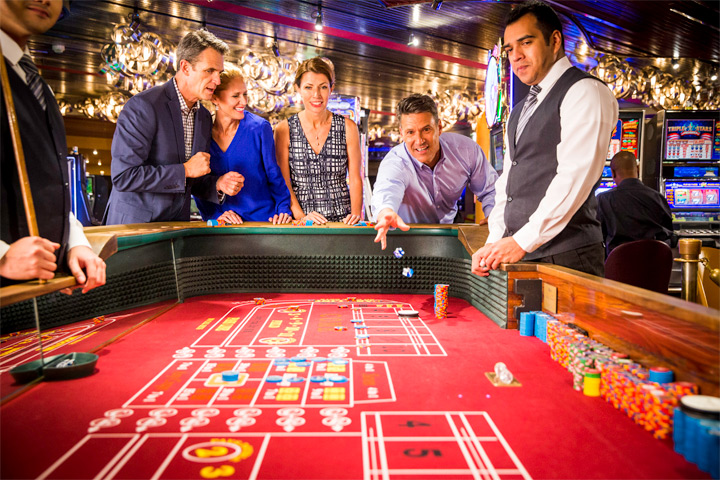
Casino
- Casino
- Fitness Center
- Culinary Arts Center
- Pool - Outdoor
- Pool - Indoor/Covered
- Sports Facilities
- Whirlpool/Jacuzzi
- Bars/Lounges
- Organized Age Specific Activities
- Teen Programs
- Concierge Desk
- Elevators
- Safe Deposit Boxes
Activities & Services (available for an extra fee)

Greenhouse Spa
- Full-Service Spa
- Spa Services/Massage
- Dry Cleaning/ Laundry Service
- Duty-Free Shops/Boutiques
- Infirmary/Medical Center
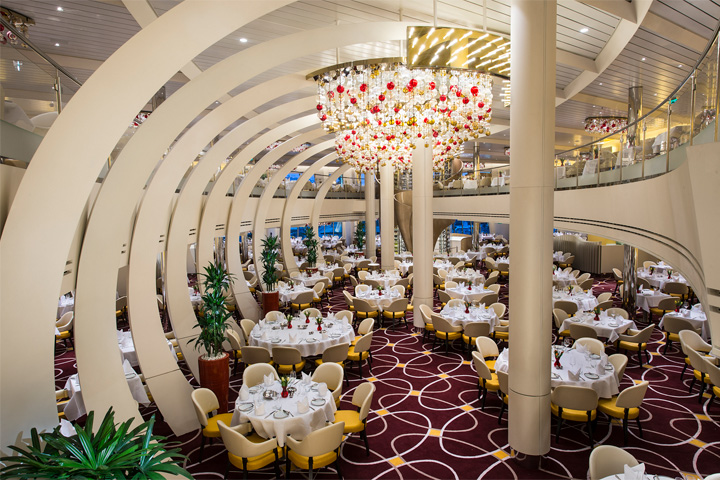
The Dining Room
Main Dining
The Dining Room: For breakfast, lunch or an unforgettable five-course dinner, the elegant main Dining Room is your destination for sophisticated dining, with menu selections from classic favorites to vegetarian options, to dishes inspired by the regions you’ll visit. Menus by Holland America Line's Culinary Council® of world-renowned chefs.
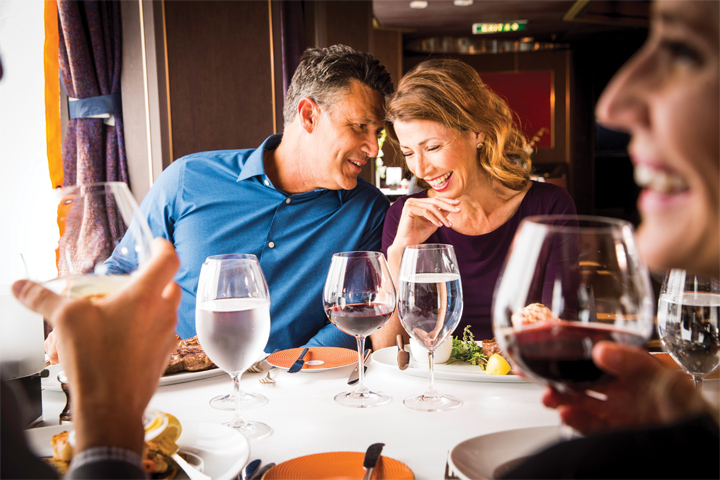
Pinnacle Grill
Specialty Dining
Pinnacle Grill: Enjoy dishes inspired by America’s Pacific Northwest, such as king salmon from Alaska and choice, responsibly raised beef from Washington State’s Double R Ranch. Complement your meal with a selection of boutique wines from the Pacific Northwest and other celebrated vineyards from around the world. This restaurant is available for an additional cost.
Canaletto: This authentic Italian restaurant offers a menu that celebrates spartire (Italian for "sharing"). Try Braised Chicken Cacciatore "al Forno," Branzino ai Ferri or a classic Italian pasta: spaghetti pomodoro or garlic shrimp-infused ravioli, perhaps. Buon appetito! This restaurant is available for an additional cost.
Tamarind: Tamarind delights diners with exotic menus evoking the culinary traditions of Southeast Asia, China and Japan. Recently noted by Condé Nast Traveler for its “cuisine that rivals the top restaurants on land,” Tamarind is located on the uppermost deck, providing stunning panoramic views. Lunch includes tantalizing items such as steamed dim sum and spicy crab. Exotic dinner menus created by Master Chef Rudi Sodamin feature dishes honoring the elements of water, wood, fire and earth. This restaurant is available for an additional cost.
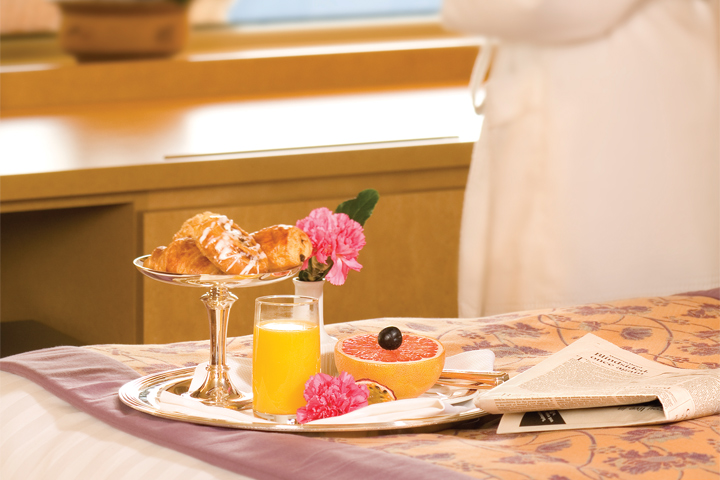
Room Service
Casual Dining
Lido Market: Lido Market provides a fresh, new approach to casual dining for breakfast, lunch or dinner, with a panoramic view of the sea. A modern marketplace with different themed stations, the Lido offers a curated selection of delicious options to grab on the go or to have quickly made to order.
Dive-In: Dive in to a grilled burger on brioche or a Nathan’s Famous gourmet hot dog. For alfresco dining by the pool, Dive-In has it all, including lighter fare like the grilled chicken breast sandwich and vegetarian-friendly portabella mushroom stack.
New York Pizza: Crisp Italian salads and personal pan pizzas made with a thin crust and a savory sauce are served up poolside.
Explorations Café: A comfortable, coffeehouse environment offering espresso drinks and pastries. This restaurant is available for an additional cost.
Grand Dutch Café: Inspired by blue and white Delftware, the Grand Dutch Café is the place to enjoy a fine pale lager or favorite coffee beverage with a traditional Dutch snack. This restaurant is available for an additional cost.
Room Service: Complimentary 24-hour dining in the comfort of your stateroom.
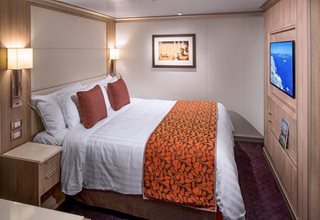
Category: IQ
Amenities- Daily housekeeping
- Complimentary 24-hour room service
- Elemis Aromapure soap, lotion, shampoo
- Luxurious bathrobes
- Generous storage
- Fresh fruit upon request
- Safe
- Ice service
- Shoeshine
- TV with On Demand movies, programming

Category: I
Amenities- Daily housekeeping
- Complimentary 24-hour room service
- Elemis Aromapure soap, lotion, shampoo
- Luxurious bathrobes
- Generous storage
- Fresh fruit upon request
- Safe
- Ice service
- Shoeshine
- TV with On Demand movies, programming

Category: J
Amenities- Daily housekeeping
- Complimentary 24-hour room service
- Elemis Aromapure soap, lotion, shampoo
- Luxurious bathrobes
- Generous storage
- Fresh fruit upon request
- Safe
- Ice service
- Shoeshine
- TV with On Demand movies, programming

Category: K
Amenities- Daily housekeeping
- Complimentary 24-hour room service
- Elemis Aromapure soap, lotion, shampoo
- Luxurious bathrobes
- Generous storage
- Fresh fruit upon request
- Safe
- Ice service
- Shoeshine
- TV with On Demand movies, programming

Category: L
Amenities- Daily housekeeping
- Complimentary 24-hour room service
- Elemis Aromapure soap, lotion, shampoo
- Luxurious bathrobes
- Generous storage
- Fresh fruit upon request
- Safe
- Ice service
- Shoeshine
- TV with On Demand movies, programming

Category: N
Amenities- Daily housekeeping
- Complimentary 24-hour room service
- Elemis Aromapure soap, lotion, shampoo
- Luxurious bathrobes
- Generous storage
- Fresh fruit upon request
- Safe
- Ice service
- Shoeshine
- TV with On Demand movies, programming
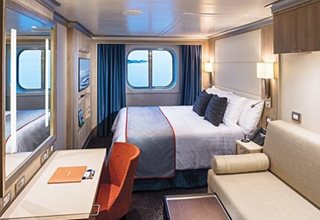
Category: FA
Amenities- Daily housekeeping
- Complimentary 24-hour room service
- Elemis Aromapure soap, lotion, shampoo
- Luxurious bathrobes
- Hair dryers, makeup mirrors
- Fresh fruit upon request
- Safe
- Ice service
- Shoeshine
- TV with On Demand movies, programming

Category: FB
Amenities- Daily housekeeping
- Complimentary 24-hour room service
- Elemis Aromapure soap, lotion, shampoo
- Luxurious bathrobes
- Hair dryers, makeup mirrors
- Fresh fruit upon request
- Safe
- Ice service
- Shoeshine
- TV with On Demand movies, programming
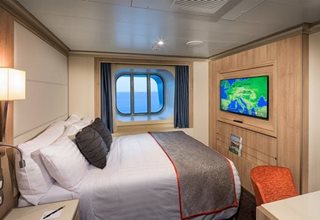
Category: CQ
Amenities- Daily housekeeping
- Complimentary 24-hour room service
- Elemis Aromapure soap, lotion, shampoo
- Luxurious bathrobes
- Hair dryers, makeup mirrors
- Fresh fruit upon request
- Safe
- Ice service
- Shoeshine
- TV with On Demand movies, programming
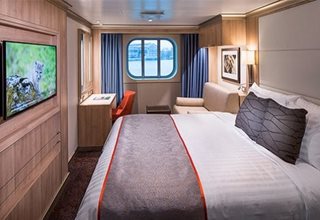
Category: C
Amenities- Daily housekeeping
- Complimentary 24-hour room service
- Elemis Aromapure soap, lotion, shampoo
- Luxurious bathrobes
- Hair dryers, makeup mirrors
- Fresh fruit upon request
- Safe
- Ice service
- Shoeshine
- TV with On Demand movies, programming

Category: D
Amenities- Daily housekeeping
- Complimentary 24-hour room service
- Elemis Aromapure soap, lotion, shampoo
- Luxurious bathrobes
- Hair dryers, makeup mirrors
- Fresh fruit upon request
- Safe
- Ice service
- Shoeshine
- TV with On Demand movies, programming

Category: E
Amenities- Daily housekeeping
- Complimentary 24-hour room service
- Elemis Aromapure soap, lotion, shampoo
- Luxurious bathrobes
- Hair dryers, makeup mirrors
- Fresh fruit upon request
- Safe
- Ice service
- Shoeshine
- TV with On Demand movies, programming

Category: F
Amenities- Daily housekeeping
- Complimentary 24-hour room service
- Elemis Aromapure soap, lotion, shampoo
- Luxurious bathrobes
- Hair dryers, makeup mirrors
- Fresh fruit upon request
- Safe
- Ice service
- Shoeshine
- TV with On Demand movies, programming
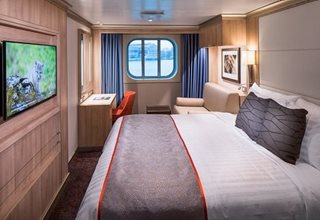
Category: OO
Amenities- Daily housekeeping
- Complimentary 24-hour room service
- Elemis Aromapure soap, lotion, shampoo
- Luxurious bathrobes
- Hair dryers, makeup mirrors
- Fresh fruit upon request
- Safe
- Ice service
- Shoeshine
- TV with On Demand movies, programming
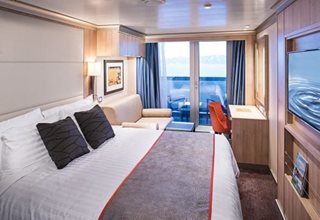
Category: VQ
Amenities- Daily housekeeping
- Complimentary 24-hour room service
- Elemis Aromapure soap, lotion, shampoo
- Luxurious bathrobes
- Hair dryers, makeup mirrors
- Fresh fruit upon request
- Safe
- Ice service
- Shoeshine
- TV with On Demand movies, programming

Category: VS
Amenities- Daily housekeeping
- Complimentary 24-hour room service
- Elemis Aromapure soap, lotion, shampoo
- Luxurious bathrobes
- Hair dryers, makeup mirrors
- Fresh fruit upon request
- Safe
- Ice service
- Shoeshine
- TV with On Demand movies, programming

Category: V
Amenities- Daily housekeeping
- Complimentary 24-hour room service
- Elemis Aromapure soap, lotion, shampoo
- Luxurious bathrobes
- Hair dryers, makeup mirrors
- Fresh fruit upon request
- Safe
- Ice service
- Shoeshine
- TV with On Demand movies, programming

Category: VA
Amenities- Daily housekeeping
- Complimentary 24-hour room service
- Elemis Aromapure soap, lotion, shampoo
- Luxurious bathrobes
- Hair dryers, makeup mirrors
- Fresh fruit upon request
- Safe
- Ice service
- Shoeshine
- TV with On Demand movies, programming

Category: VB
Amenities- Daily housekeeping
- Complimentary 24-hour room service
- Elemis Aromapure soap, lotion, shampoo
- Luxurious bathrobes
- Hair dryers, makeup mirrors
- Fresh fruit upon request
- Safe
- Ice service
- Shoeshine
- TV with On Demand movies, programming

Category: VC
Amenities- Daily housekeeping
- Complimentary 24-hour room service
- Elemis Aromapure soap, lotion, shampoo
- Luxurious bathrobes
- Hair dryers, makeup mirrors
- Fresh fruit upon request
- Safe
- Ice service
- Shoeshine
- TV with On Demand movies, programming

Category: VD
Amenities- Daily housekeeping
- Complimentary 24-hour room service
- Elemis Aromapure soap, lotion, shampoo
- Luxurious bathrobes
- Hair dryers, makeup mirrors
- Fresh fruit upon request
- Safe
- Ice service
- Shoeshine
- TV with On Demand movies, programming

Category: VE
Amenities- Daily housekeeping
- Complimentary 24-hour room service
- Elemis Aromapure soap, lotion, shampoo
- Luxurious bathrobes
- Hair dryers, makeup mirrors
- Fresh fruit upon request
- Safe
- Ice service
- Shoeshine
- TV with On Demand movies, programming

Category: VF
Amenities- Daily housekeeping
- Complimentary 24-hour room service
- Elemis Aromapure soap, lotion, shampoo
- Luxurious bathrobes
- Hair dryers, makeup mirrors
- Fresh fruit upon request
- Safe
- Ice service
- Shoeshine
- TV with On Demand movies, programming

Category: VH
Amenities- Daily housekeeping
- Complimentary 24-hour room service
- Elemis Aromapure soap, lotion, shampoo
- Luxurious bathrobes
- Hair dryers, makeup mirrors
- Fresh fruit upon request
- Safe
- Ice service
- Shoeshine
- TV with On Demand movies, programming
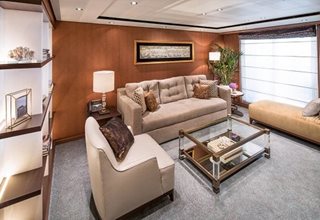
Category: PS
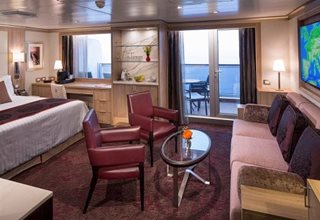
Category: SQ
Amenities- Daily housekeeping
- Complimentary 24-hour room service
- Elemis Aromapure soap, lotion, shampoo
- Premium bathrobes, slippers
- Hair dryers, makeup mirrors
- Fresh fruit upon request
- Safe
- Ice service
- Shoeshine
- TV with On Demand movies, programming
- Fresh flowers
- One-Touch concierge service
- Whirlpool bath (suite dependent)
- In-suite coffee, espresso
- Complimentary laundry
- Pre-dinner hors d'oeuvres served in suite
- Welcome glass of sparkling wine
- Priority boarding for tender ports, priority dining/seating requests, special disembarkation service
- High tea in suite on request
- Binoculars
- Exclusive tote bag

Category: SA
Amenities- Daily housekeeping
- Complimentary 24-hour room service
- Elemis Aromapure soap, lotion, shampoo
- Premium bathrobes, slippers
- Hair dryers, makeup mirrors
- Fresh fruit upon request
- Safe
- Ice service
- Shoeshine
- TV with On Demand movies, programming
- Fresh flowers
- One-Touch concierge service
- Whirlpool bath (suite dependent)
- In-suite coffee, espresso
- Complimentary laundry
- Pre-dinner hors d'oeuvres served in suite
- Welcome glass of sparkling wine
- Priority boarding for tender ports, priority dining/seating requests, special disembarkation service
- High tea in suite on request
- Binoculars
- Exclusive tote bag

Category: SB
Amenities- Daily housekeeping
- Complimentary 24-hour room service
- Elemis Aromapure soap, lotion, shampoo
- Premium bathrobes, slippers
- Hair dryers, makeup mirrors
- Fresh fruit upon request
- Safe
- Ice service
- Shoeshine
- TV with On Demand movies, programming
- Fresh flowers
- One-Touch concierge service
- Whirlpool bath (suite dependent)
- In-suite coffee, espresso
- Complimentary laundry
- Pre-dinner hors d'oeuvres served in suite
- Welcome glass of sparkling wine
- Priority boarding for tender ports, priority dining/seating requests, special disembarkation service
- High tea in suite on request
- Binoculars
- Exclusive tote bag

Category: SC
Amenities- Daily housekeeping
- Complimentary 24-hour room service
- Elemis Aromapure soap, lotion, shampoo
- Premium bathrobes, slippers
- Hair dryers, makeup mirrors
- Fresh fruit upon request
- Safe
- Ice service
- Shoeshine
- TV with On Demand movies, programming
- Fresh flowers
- One-Touch concierge service
- Whirlpool bath (suite dependent)
- In-suite coffee, espresso
- Complimentary laundry
- Pre-dinner hors d'oeuvres served in suite
- Welcome glass of sparkling wine
- Priority boarding for tender ports, priority dining/seating requests, special disembarkation service
- High tea in suite on request
- Binoculars
- Exclusive tote bag
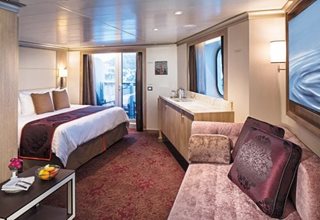
Category: SS
Amenities- Daily housekeeping
- Complimentary 24-hour room service
- Elemis Aromapure soap, lotion, shampoo
- Luxurious bathrobes
- Hair dryers, makeup mirrors
- Generous storage
- Fresh fruit upon request
- Safe
- Ice service
- Shoeshine
- TV with On Demand movies, programming
- Binoculars

Category: SY
Amenities- Daily housekeeping
- Complimentary 24-hour room service
- Elemis Aromapure soap, lotion, shampoo
- Luxurious bathrobes
- Hair dryers, makeup mirrors
- Generous storage
- Fresh fruit upon request
- Safe
- Ice service
- Shoeshine
- TV with On Demand movies, programming
- Binoculars
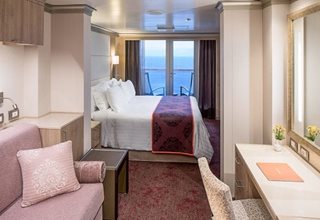
Category: AS
Amenities- Daily housekeeping
- Complimentary 24-hour room service
- Elemis Aromapure soap, lotion, shampoo
- Luxurious bathrobes
- Hair dryers, makeup mirrors
- Generous storage
- Fresh fruit upon request
- Safe
- Ice service
- Shoeshine
- TV with On Demand movies, programming
- Binoculars

Category: A
Amenities- Daily housekeeping
- Complimentary 24-hour room service
- Elemis Aromapure soap, lotion, shampoo
- Luxurious bathrobes
- Hair dryers, makeup mirrors
- Generous storage
- Fresh fruit upon request
- Safe
- Ice service
- Shoeshine
- TV with On Demand movies, programming
- Binoculars

Category: B
Amenities- Daily housekeeping
- Complimentary 24-hour room service
- Elemis Aromapure soap, lotion, shampoo
- Luxurious bathrobes
- Hair dryers, makeup mirrors
- Generous storage
- Fresh fruit upon request
- Safe
- Ice service
- Shoeshine
- TV with On Demand movies, programming
- Binoculars

Category: BC
Amenities- Daily housekeeping
- Complimentary 24-hour room service
- Elemis Aromapure soap, lotion, shampoo
- Luxurious bathrobes
- Hair dryers, makeup mirrors
- Generous storage
- Fresh fruit upon request
- Safe
- Ice service
- Shoeshine
- TV with On Demand movies, programming
- Binoculars
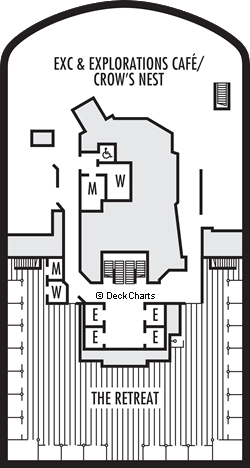
| Symbol | Description |
|---|---|
 | Quad (2 lower beds, 1 sofa bed, 1 upper) |
 | Triple (2 lower beds, 1 upper) |
 | Triple (2 lower beds, 1 sofa bed) |
 | Double (2 lower beds convertible to 1 king-size bed, no Murphy bed) |
 | Partially obstructed view |
 | Connecting rooms |
 | Floor-to-ceiling windows |
 | Shower only |
 | Uncovered verandah |
 | Staterooms have solid steel verandah railings instead of clear-view plexiglass railings |
 | Fully accessible, roll-in shower only |
 | Ambulatory accessible, shower only with small step, step into bathroom, standard interior and exterior door size |
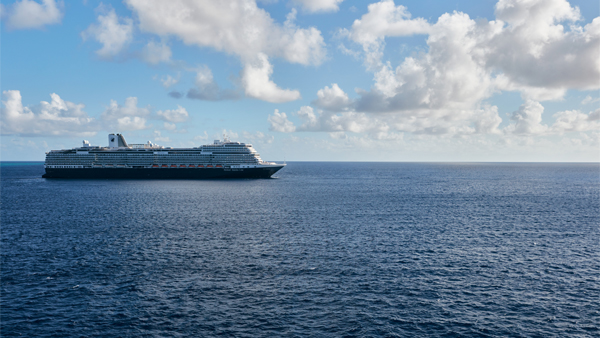
- Ship Name: Nieuw Statendam
- Year Built: 2017
- Year Entered Present Fleet: 2018
- Ship Class: Pinnacle
- Maximum Capacity: 2,666
- Number of Passenger Decks: 13
- Number of Crew: 1,036
- Officers' Nationality: International
- Tonnage (GRT): 99,500
- Country of Registry: Netherlands
- Crew/Hotel Staff Nationality: International
Costco Member Reviews

Available Dates & Prices
Terms & Conditions
*Price shown is per person based on double occupancy and is valid for select stateroom categories only. Click on the Terms & Conditions link below for details.
†One Digital Costco Shop Card per room/stateroom, per stay. The exact amount of the Digital Costco Shop Card will be calculated during the booking process. The Digital Costco Shop Card promotion is nontransferable and may not be combined with any other promotion. A Digital Costco Shop Card will arrive by email approximately 10 days after the start of your cruise. Click on the Terms & Conditions link below for additional information.
Ship's registry: The Netherlands
Digital Costco Shop Card
This booking includes a Digital Costco Shop Card which will arrive by email one to two weeks after you return from your vacation. The Digital Costco Shop Card is a convenient payment option in our warehouses and on Costco.ca.















